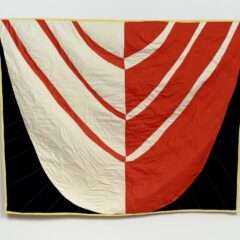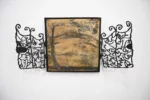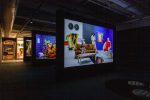5 Under 40, the show at Sande Webster Gallery this month, unsurprisingly consists of five artists under the age of 40. One of those showing his work, Philippe Jean, is also the curator of the show. The questions and practices asserted by these artists demonstrate both wry social criticism as well as strong visual references.
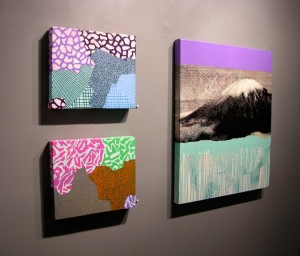
Jean’s pieces have an immediately apparent pop sensibility. When viewing his rendering of Mount Fuji, I couldn’t help but think that the pixelated print is undoubtedly a nod to Roy Lichtenstein’s comic book frames. This piece in particular is also an unofficial homage to Hokusai, and certainly a deviation from Jean’s other pieces in the show.
Directly to the left of Mount Fuji lie four smaller patterned plains of strikingly vibrant hues. At first glance, they appear to be just nonobjective patterns, but upon further discussion their underlying concepts were uncovered.
The texturing of the pieces actually derives from the material on the inside of envelopes intended to obscure bills or checks. As this realization dawned on me, Jean explained that the use of the material in his pieces was in some ways a means of escaping the debt contained within those selfsame envelopes – through selling art. The patterns’ enigmatic origin also creates a sort of visual trope, in that they were originally created by their designers in order to not be seen. In fact, they were designed so that the viewer would not be able to see. By turning the established practice on its head, Jean effectively fights the debt-monster, and even greed itself, in an amusing, intelligent way.
Also conceptually strong is artist Amze Emmons, who portrays images of poor urban areas in depopulated, colorized scenes. With a background in printmaking, and an interest in historic posters and vintage comics, Emmons employs a multi-step process to create his vivid images.
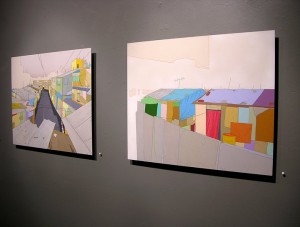
Starting with street photography, Emmons desaturates and prints his photos, reduces them to more illustrated outlines, and then re-colorizes them without referencing the original. What emerge are subtle, graphic mashups of otherwise real places. They are at once serenely precise and hauntingly barren. The once unforgiving landscapes are transformed into simplified and brightened versions; a type of escapism or revision for tough times and harsh conditions.
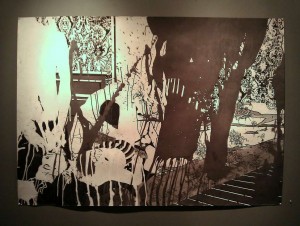
Two artists in this show appear as stark opposites. On one hand, Doron Langberg’s Motherwell-meets-Pollock paintings twist and turn in black and white (yet sometimes sparkly) splotches. They are fairly large – over three feet – and spattered with what appear to be bits of doily or wallpaper patterns.
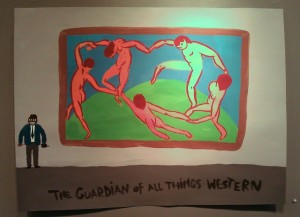
In antithesis are Jayson Musson’s figurative, captioned pieces. They are all wrought with some social or political message, paired with simple, humorous pictures. One image reads, “The artist in all his glory,” and depicts a naked man standing atop his own gigantic, curved penis. Another, “The guardian of all things Western,” shows an image of Matisse’s “The Dance” with a glum-looking docent keeping watch nearby. The backgrounds are comprised of flat colors, while the campy subjects are the primary focus.
Claes Gabriel’s 3-Dimensional paintings are certainly a highlight of 5 Under 40. Some hanging on the wall, others standing tall, these brightly adorned artifacts draw from many sources to produce stunning curved forms. Gabriel told me that he was initially inspired by 60s painters like Frank Stella, who worked on shaped canvases. After pressing in the side of one of his own works, Gabriel demonstrated that, although they appear solid, his pieces were themselves made of stretched canvas and bent wooden spines.
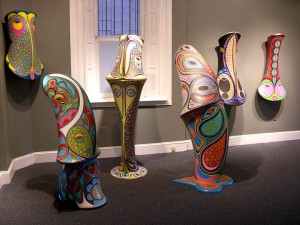
From that starting point, he took elements of African tribal masks and sculptures to form his various kaleidoscopic totems. Contrasting colors and concentric circles mimic eyes and form indistinct faces along their surfaces. The textured bumps of darker areas ripple into paisley drops as these strange creatures stand tall and alert, gazing back at onlookers. They are the silent sentries of this vibrant show.


